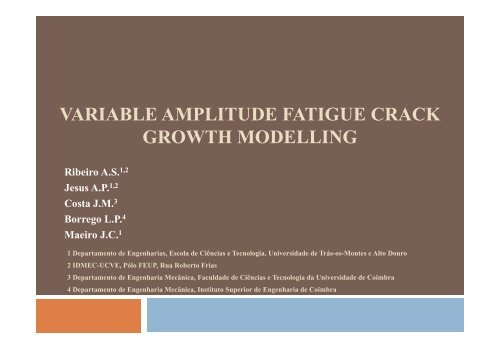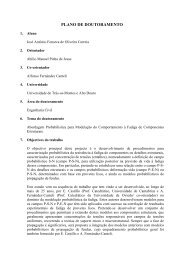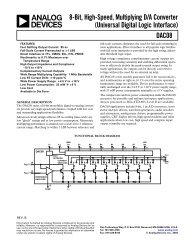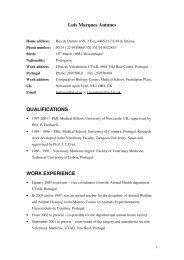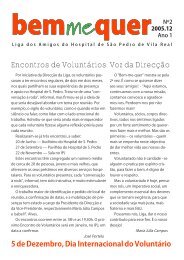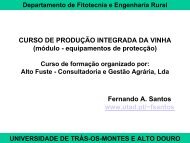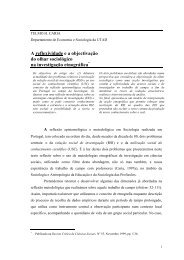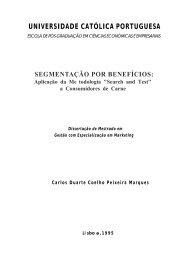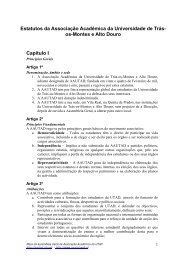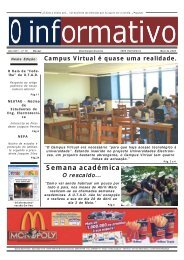variable amplitude fatigue crack growth modelling - Universidade de ...
variable amplitude fatigue crack growth modelling - Universidade de ...
variable amplitude fatigue crack growth modelling - Universidade de ...
You also want an ePaper? Increase the reach of your titles
YUMPU automatically turns print PDFs into web optimized ePapers that Google loves.
VARIABLE AMPLITUDE FATIGUE CRACKGROWTH MODELLINGRibeiro A.S. 1,2Jesus A.P. 1,2Costa J.M. 3Borrego L.P. LP 4Maeiro J.C. 11 Departamento <strong>de</strong> Engenharias, Escola <strong>de</strong> Ciências e Tecnologia, <strong>Universida<strong>de</strong></strong> <strong>de</strong> Trás-os-Montes e Alto Douro2 IDMEC-UCVE, Pólo FEUP, Rua Roberto Frias3 Departamento <strong>de</strong> Engenharia Mecânica, Faculda<strong>de</strong> <strong>de</strong> Ciências e Tecnologia da <strong>Universida<strong>de</strong></strong> <strong>de</strong> Coimbra4 Departamento <strong>de</strong> Engenharia Mecânica, Instituto Superior <strong>de</strong> Engenharia <strong>de</strong> Coimbra
INTRODUCTION Fatigue <strong>crack</strong> propagation may occur un<strong>de</strong>r random, <strong>variable</strong><strong>amplitu<strong>de</strong></strong> or in constant <strong>amplitu<strong>de</strong></strong> loading;Un<strong>de</strong>r <strong>variable</strong> <strong>amplitu<strong>de</strong></strong> loading, the load sequence effect is a majorfactor in <strong>de</strong>termining the <strong>fatigue</strong> life;Due to the random nature of <strong>variable</strong> loading, significant accelerationsand/or retardations in <strong>crack</strong> <strong>growth</strong> rate may occur;
INTRODUCTIONOverloads are known to retard <strong>crack</strong> <strong>growth</strong>, while un<strong>de</strong>rloads generallyaccelerate <strong>crack</strong> <strong>growth</strong> relatively to the baseline <strong>crack</strong> <strong>growth</strong> rate;The overloads and un<strong>de</strong>rloads, which are highly <strong>de</strong>pen<strong>de</strong>nt upon theloading sequence, make the prediction of <strong>fatigue</strong> life un<strong>de</strong>r <strong>variable</strong><strong>amplitu<strong>de</strong></strong> loading more complex than un<strong>de</strong>r constant <strong>amplitu<strong>de</strong></strong> loading;Many mo<strong>de</strong>ls have been <strong>de</strong>veloped to predict the <strong>fatigue</strong> life ofcomponents un<strong>de</strong>r <strong>variable</strong> <strong>amplitu<strong>de</strong></strong> loading, namely by Wheeler,Willemborg , Elber and Newman .
OBJECTIVESThe goal of this work is to <strong>de</strong>scribe mo<strong>de</strong>ls dl available to predict <strong>crack</strong><strong>growth</strong>, using <strong>variable</strong> <strong>amplitu<strong>de</strong></strong> loading sequences.
LOAD INTERACTIONS EFFECTS UNDER SIMPLEVARIABLE AMPLITUDE LOAD SEQUENCES
LOAD INTERACTIONS EFFECTS UNDER SIMPLEVARIABLE AMPLITUDE LOAD SEQUENCESTypical effect of periodically applied overloads for several numbersof baseline cycles between overloads for 2024-T3 aluminium alloy.
LOAD INTERACTIONS EFFECTS UNDER SIMPLEVARIABLE AMPLITUDE LOAD SEQUENCESBehaviour generally observed in load interaction phenomenon highlow(Hi-Lo), low-high (Lo-Hi) following an un<strong>de</strong>rload??rever!.(a)(b)da/dNda/dNK 1K 2Crack length, aK 12 1K 2Crack length, a
LOAD INTERACTIONS EFFECTS UNDER SIMPLEVARIABLE AMPLITUDE LOAD SEQUENCESLoad interaction effects un<strong>de</strong>r simple <strong>variable</strong> <strong>amplitu<strong>de</strong></strong> loadsequences.length, aCrack lload variationApplied cycles, N
MODELS FOR VARIABLE AMPLITUDE FATIGUECRACK GROWTHRetardation mo<strong>de</strong>ls may be classified into two maincategories:• Crack tip plasticity mo<strong>de</strong>ls• Crack Cac closure cosuemo<strong>de</strong>ls
WHEELER MODELThis mo<strong>de</strong>l dlcalculates l the fti <strong>fatigue</strong> <strong>crack</strong> <strong>growth</strong> retardationtiwhen a single tensile overload is applied.The Wheeler mo<strong>de</strong>l is characterized by the introduction ofa retardation parameter, R , which prescribes a reduced<strong>growth</strong> rate for <strong>fatigue</strong> <strong>crack</strong>s.Applying the Wheeler mo<strong>de</strong>l to the Paris’s law results thefollowing equation:dadNm CKR
WHEELER MODELThe retardation parameter, R , is <strong>de</strong>fined as:R a1,OLrp,i rOL ain, ai raip,i rp,i< aOL a rOLOL rOL• a OL is the <strong>crack</strong> length when the overload is applied• a i is the <strong>crack</strong> length at each load cycle i;• r OL is the size of the plastic zone produced by the overload at a OL ;• r p,i is the size of plastic zone produced by the post-overload constant<strong>amplitu<strong>de</strong></strong> loading at current <strong>crack</strong> length a i ;• n is an adjustable experiment-based shaping exponent, <strong>de</strong>pends on thetype of material, geometry and overload magnitu<strong>de</strong>.
WILLEMBORG MODELThe Willemborg mo<strong>de</strong>l suggest the use of an effective stressintensity factor, when an overload is applied, <strong>de</strong>fined by thefollowing expression:(K ) K ieffiKRed (K i ) eff and K i is the effective and apparent (un<strong>de</strong>r constant <strong>amplitu<strong>de</strong></strong>) stressintensity factors in each load cycle i, respectively.K Red , is given by the following equation:KRe d KOL1 ai arOLOL Kmax,i K OL is the overload stress intensity factor and K max,i the maximum stressintensity factor in each load cycle i.
WILLEMBORG MODEL Willemborg proposed the Forman equation to predict the<strong>crack</strong> <strong>growth</strong> propagation when a overload is applied:dadNC (K(1 R ) Keffeffc)n KeffK c isthecritical ii stress intensityi factor.In this mo<strong>de</strong>l the retardation effect, in the <strong>crack</strong> <strong>growth</strong> is<strong>de</strong>fined using the effective stress ratio in each load cycle i,(R i ) eff , given by:( K( Ri) eff ( Kmin,imax,i))effeff
CRACK CLOSURE MODELThe <strong>crack</strong> closure approach permits to correlate the majorityof the <strong>crack</strong> c <strong>growth</strong> gow transients se sobserved un<strong>de</strong>r u<strong>de</strong> simple <strong>variable</strong><strong>amplitu<strong>de</strong></strong> loading sequences using experimental <strong>crack</strong> closuremeasurements.However the K op must be obtained for the specific materialand loading condition or by an approximated expression of theevolution of the opening stress proposed from experimental<strong>crack</strong> closure measurements, which is very complex and timeconsuming.
CRACK CLOSURE MODELElber suggest that the effective stress intensity range, K eff , shouldbe obtain by the following expression:KeffKmaxKopK op represents the stress intensity factor corresponding to the opening stress ofthe <strong>crack</strong>, op.The retardation effect in the <strong>crack</strong> <strong>growth</strong> can be obtained by:dadNf(K)eff
WHEELER MODEL ENHANCEMENTSimilaril to the original i Wheeler mo<strong>de</strong>l, dl Yuen and Th Taheri appliedsome modifications to the Wheeler mo<strong>de</strong>l using the equation in thefollowing form:dadN RDICKacm• R is the retardation parameter as <strong>de</strong>fined in the original Wheelermo<strong>de</strong>l;• D is the <strong>de</strong>lay parameter;• I is the overload interaction parameter• K ac is the accelerated stress intensity factor range Un<strong>de</strong>r constant <strong>amplitu<strong>de</strong></strong> stable <strong>crack</strong> <strong>growth</strong>, R =1, D =1, I =1 andK ac =K.
WHEELER MODEL ENHANCEMENTThe <strong>de</strong>layed-retardation parameter D is <strong>de</strong>fined as:Da 1,OL rrd,OLd,i aiq,a ria rid,id,i< a aOLOL r rd,OLd,OLr d,OL is the size of the overload effective <strong>de</strong>lay zone;r d,i is the size of the current effective <strong>de</strong>lay zone;q is the shaping exponent for the modified mo<strong>de</strong>l.
WHEELER MODEL ENHANCEMENTThesizeoftheoverload effective <strong>de</strong>lay zone and of the currenteffective <strong>de</strong>layed zone can be assumed to be calculated using thefollowing formula:rd K YS 2 is the effective <strong>de</strong>lay zone size constant
WHEELER MODEL ENHANCEMENTThe overload interaction parameter I is <strong>de</strong>fined as presented inthese formulas:1 1 min,i I 1 1 min,i1,q rp,iaOL rd ,OL ai1 , ai rd ,i aOL rd ,OLaOL rp,OL aird ,i q rp,i1 , aOL rd ,OL ai rd ,i ,ai rp,i aOL rp,OLaOL rp,OL aiaOL rp,OL ai rp,i
WHEELER MODEL ENHANCEMENTThe accelerated stress intensity factor range, K ac, is <strong>de</strong>fined in themodified Wheeler mo<strong>de</strong>l as presented in equation:KacK Kii,KOL Ki1aOLr rd ,id ,OL aiq,aia rOLd ,ir ap,OLOLa rid ,OLrp, iK OL is the overload stress intensity factor range and K i the current stressintensity factor in each load cycle i.
WHEELER MODEL ENHANCEMENTCrack <strong>growth</strong> <strong>mo<strong>de</strong>lling</strong> proposed by Xiaoping Huang, introducethe retardation parameter R of the original Wheeler mo<strong>de</strong>l, withsmall modification to consi<strong>de</strong>r un<strong>de</strong>rload effects.dadN CmK eq K0th0mKeq0MRMPK• K th0 is the threshold at R=0, C and m are those corresponding to R=0 andparameters M R and M P are correction factors for the equivalent stressintensity factor range.
WHEELER MODEL ENHANCEMENTM R is the correction factor of the stress ratio effect:MR 1R1 , 1 R,1.05 1.4R 0.6R2- 5R00 R 0.5 ,0.5 R 1 where and 1 are parameters <strong>de</strong>pending on material properties .
WHEELER MODEL ENHANCEMENT The loading sequenceinteraction correction factor M Pis <strong>de</strong>fined as:MP a1,OLr rPOL a rn,a ra rPP< a aOLOL r rOLOL rn is a shaping exponent <strong>de</strong>terminedby fitting to the experimental data,set to the same value for the samematerial;r
WHEELER MODEL ENHANCEMENT The r can be quantitatively calculated using the followingequations:Kur Y K auYSi1min2 imini1i YS is the compressive yield stress and minmin the minimum stresses up to andfollowing the ith overload, respectively.
CONCLUSIONSSome relevant fti <strong>fatigue</strong> <strong>crack</strong> <strong>growth</strong> mo<strong>de</strong>ls dl un<strong>de</strong>r <strong>variable</strong> ibl<strong>amplitu<strong>de</strong></strong> loading have been presented.There are merits and limitations of each mo<strong>de</strong>l.From the literature it is observed that most of the mo<strong>de</strong>lsrequire one or more calibration parameters or constants toconduct <strong>crack</strong> <strong>growth</strong> analysis.It is necessary the use of curve fitting as an importedprocedure to correlate the predictions with the experimentaldata.Due to the number and complexity of the mechanismsinvolved in this problem, no universal mo<strong>de</strong>l exists yet.The selection of the appropriate mo<strong>de</strong>l is usually based onthe researcher experience and persona1 preference, thusaccurate predictions remain problematic.
THANKS FOR YOUR ATTENTIONRibeiro A.S.Jesus A.P.Costa J.M.Borrego L.P.Maeiro J.C.


